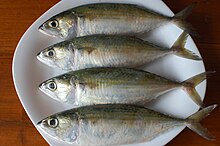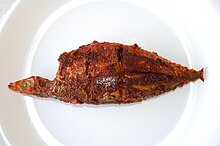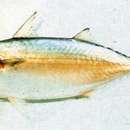Benefits
provided by FAO species catalogs
Indian mackerel is a very important species in many parts of its range. Catches are usually recorded as Rastrelliger spp. or combined with R. brachysoma . In the last 25 years, the world catch for R. kanagurta alone fluctuated between about 96,000 t in 1975 and a peak of 351,193 t in 1994; since 1984, catches reported to FAO as Rastrelliger spp. have exceeded 300,000 t. In the Western Indian Ocean area most of the catches (about 185 000 t in 1995) are identified as R. kanagurta while in in the Eastern Indian Ocean 224 000 t are reported as Rastrelliger spp. and 43 000 t as R. kanagurta . Instead, in the Western Central Pacific, which ranks as the area of major catches for Rastrelliger species, 252 000 t are not identified at the species level, 104 000 t are identified as R. kanagurta and 26 000 t as R. brachysoma . Indian mackerel is caught with purse seines , encircling gillnets, high-opening bottom trawl, lift nets, and bamboo stake traps. ("indian mackerel fishing") Marketed fresh, frozen, canned, dried salted, and smoked. The total catch reported for this species to FAO for 1999 was 302 387 t. The countries with the largest catches were India (146 367 t) and Pilippines (53 606 t).
- bibliographic citation
- FAO Species Catalogue. Vol. 2. Scombrids of the world. An annotated and illustrated catalogue of Tunas, Mackerels, Bonitos and related species known to date.Collette, B.B. & C.E. Nauen 1983.. FAO Fish. Synop., (125)Vol.2:137 p.
- author
- Food and Agriculture Organization of the UN
Brief Summary
provided by FAO species catalogs
An epipelagic,neriticspecies occurring in areas where surface water temperatures are at least 17° C. Schooling is by size. The spawning season around India seems to extend from March through September. Spawning is in several batches. Juveniles feed on phytoplankton (i.e. diatoms) and small zooplankton such as cladocerans, ostracods, larval polychaetes, etc. With growth they gradually chance their dietary habits, a process that is reflected in the relative shortening of their intestine. Hence, adult Indian mackerel prey primarily on macroplankton such as larval shrimps and fish.Longevity is believed to be at least 4 years.
- bibliographic citation
- FAO Species Catalogue. Vol. 2. Scombrids of the world. An annotated and illustrated catalogue of Tunas, Mackerels, Bonitos and related species known to date.Collette, B.B. & C.E. Nauen 1983.. FAO Fish. Synop., (125)Vol.2:137 p.
- author
- Food and Agriculture Organization of the UN
Size
provided by FAO species catalogs
Maximum fork length is 35 cm, common to 25 cm; in Philippine waters, length at first maturity is about 23 cm.
- bibliographic citation
- FAO Species Catalogue. Vol. 2. Scombrids of the world. An annotated and illustrated catalogue of Tunas, Mackerels, Bonitos and related species known to date.Collette, B.B. & C.E. Nauen 1983.. FAO Fish. Synop., (125)Vol.2:137 p.
- author
- Food and Agriculture Organization of the UN
Distribution
provided by FAO species catalogs
Widespread in the Indo-West Pacific from South Africa, Seychelles and Red Sea east through Indonesia and off northern Australia to Melanesia, Micronesia, Samoa, China and the Ryukyu Islands. It has entered the eastern Mediterranean Sea through the Suez Canal.
- bibliographic citation
- FAO Species Catalogue. Vol. 2. Scombrids of the world. An annotated and illustrated catalogue of Tunas, Mackerels, Bonitos and related species known to date.Collette, B.B. & C.E. Nauen 1983.. FAO Fish. Synop., (125)Vol.2:137 p.
- author
- Food and Agriculture Organization of the UN
Diagnostic Description
provided by FAO species catalogs
Body moderately deep, its depth at margin of gill cover 4.3 to 5.2 times in fork length; head longer than body depth. Maxilla partly concealed, covered by the lacrimal bone, but extending to about hind margin of eye; gillrakers very long, visible when mouth is opened, 30 to 46 on lower limb of first arch; a moderate number of bristles on longest gillraker, 105 on one side in specimens of 12.7 cm, 140 in specimens of 16 cm, and 160 in specimens of 19 cm fork length. Intestine 1.4 to 1.8 times fork length. Colour: narrow dark longitudinal bands on upper part of body (golden in fresh specimens) and a black spot on body near lower margin of pectoral fin; dorsal fins yellowish with black tips, caudal and pectoral fins yellowish; other fins dusky.
- Fischer & Whitehead, eds (1974, Species Identification Sheets, Eastern Indian Ocean/Western Central Pacific)
- Jones & Silas, (1964a)
- bibliographic citation
- FAO Species Catalogue. Vol. 2. Scombrids of the world. An annotated and illustrated catalogue of Tunas, Mackerels, Bonitos and related species known to date.Collette, B.B. & C.E. Nauen 1983.. FAO Fish. Synop., (125)Vol.2:137 p.
- author
- Food and Agriculture Organization of the UN
Diagnostic Description
provided by Fishbase
Head longer than body depth. Maxilla partly concealed, covered by lachrymal bone but extending to about hind margin of eye. Bristles on longest gill raker 105 on one side in specimens of 12.7 cm, 140 in 16 cm, and 160 in 19 cm fork length specimens. A black spot on body near lower margin of pectoral fin. Interpelvic process small and single. Swim bladder present. Anal spine rudimentary.Description: Characterized further by silvery body color with several dark stripes on upper half side, upper ones breaking into spots posteriorly; whole body covered by scales, those at anterior part larger but not developed as a corselet; moderately compressed body; large mouth, maxilla extending posterior to rear margin of eye; very small teeth in jaws, none on vomer or palatines (Ref. 90102).
Diseases and Parasites
provided by Fishbase
Lecithocladium Infestation 1. Parasitic infestations (protozoa, worms, etc.)
Diseases and Parasites
provided by Fishbase
Eyelavera Infestation. Parasitic infestations (protozoa, worms, etc.)
Diseases and Parasites
provided by Fishbase
Pseudoanthocotyle Infestation. Parasitic infestations (protozoa, worms, etc.)
Migration
provided by Fishbase
Oceanodromous. Migrating within oceans typically between spawning and different feeding areas, as tunas do. Migrations should be cyclical and predictable and cover more than 100 km.
Morphology
provided by Fishbase
Dorsal spines (total): 8 - 11; Dorsal soft rays (total): 12; Analspines: 0; Analsoft rays: 12
Trophic Strategy
provided by Fishbase
Juveniles feed on phytoplankton (e.g., diatoms) and small zooplankton such as cladoceran, ostracods, larval polychaetes, etc. With growth, they gradually change their dietary habits, a process that is reflected in the relative shortening of the intestine (Ref. 30531).
Biology
provided by Fishbase
Adults occur in coastal bays, harbors and deep lagoons, usually in some turbid plankton-rich waters. Form schools. Feed on phytoplankton (diatoms) and small zooplankton (cladocerans, ostracods, larval polychaetes, etc.) (Ref. 9684). Small groups were seen eating eggs of Cheilio inermis straight after spawning (Ref. 48637). Adult individuals feed on macroplankton such as larval shrimps and fish. Eggs and larvae are pelagic (Ref. 6769). Generally marketed fresh, frozen, canned, dried-salted, and smoked; also made into fish sauce (Ref. 9684).
Importance
provided by Fishbase
fisheries: highly commercial; gamefish: yes; bait: occasionally; price category: very high; price reliability: reliable: based on ex-vessel price for this species
分布
provided by The Fish Database of Taiwan
廣泛分布於印度-西太平洋區,西起非洲東岸、紅海,東至薩摩亞;北自日本,南迄印尼,澳洲北部海域。台灣各地皆有產,尤以東部海域為甚。
利用
provided by The Fish Database of Taiwan
許多沿岸國重要之食用魚。全世界一年估計產100,000-500,000公噸。一般漁法以圍網、定置網、流刺網等捕獲。煎食或紅燒皆宜,亦可加工成鹽漬品。
描述
provided by The Fish Database of Taiwan
體紡錐形,側扁,橫切面橢圓形,背緣和腹緣略弧形隆起;尾柄細短,兩側在尾鰭基部各具2條小隆起脊。頭中大,稍側扁。吻鈍尖,稍大於眼徑。眼中大,位近頭的背緣,具發達之脂性眼瞼。口大,端位,斜裂;上下頜等長,上下頜齒具1列細齒,上頜齒常退化;鋤骨、腭骨和舌上均無齒。鰓耙羽狀,第一鰓弓上之下枝鰓耙數為30-46。體及頰部被圓鱗;側線完全,沿背側延伸,伸達尾鰭基。第一背鰭具硬棘X,與第二背鰭起點距離遠,其後具5-6個離鰭;臀鰭與第二背鰭同形;尾鰭深叉形。體背青綠色,具1-2列黑色斑塊,體腹銀白色。體側近胸鰭下緣具一黑斑。
棲地
provided by The Fish Database of Taiwan
外海大洋性中上層洄游性魚類,有時會進入較深之潟湖區。好群游,具趨光性,有垂直移動現象。主要攝食浮游性端腳類,橈腳類及甲殼類之幼蟲。
Indian mackerel
provided by wikipedia EN

Indian mackerel, cleaned and scored and its roe. The heads have been removed.
The Indian mackerel (Rastrelliger kanagurta) is a species of mackerel in the scombrid family (family Scombridae) of order Perciformes.[2] It is commonly found in the Indian and West Pacific oceans, and their surrounding seas. It is an important food fish and is commonly used in South and South-East Asian cuisine.
It is known by various names, such as Pelaling in Malaysia and Indonesia,Bangdo (बांगडो) in Konkani language, Bangdi (બાંગડી) in Gujarati, Bangda (बांगडा) in Marathi, Kajol Gouri (কাজল গৌরী) in Bengali, Ayla (അയല, ഐല) in Malayalam, Kankarta (କାନକରତା) in Odia, Kaanankeluthi (காணாங்கெலுத்தி) in Tamil and Bangude (ಬಂಗುಡೆ) in Tulu, and Kannada.
Distribution and habitat
The Indian mackerel is found in warm shallow waters along the coasts of the Indian and Western Pacific oceans. Its range extends from the Red Sea and East Africa in the west to Indonesia in the east, and from China and the Ryukyu Islands in the north to Australia, Melanesia and Samoa in the south.[3] It has been reported on two occasions (1967, 2010) in the Mediterranean Sea off Israel, a likely entry via the Suez Canal.[4]
Description
The body of the Indian mackerel is moderately deep, and the head is longer than the body depth. The maxilla are partly concealed, covered by the lacrimal bone, but extend till around the hind margin of the eye.[5]
These fish have thin dark longitudinal bands on the upper part of the body, which may be golden on fresh specimens. There is also a black spot on the body near the lower margin of the pectoral fin. Dorsal fins are yellowish with black tips, while the caudal and pectoral fins are yellowish. The remaining fins are dusky.[5]
Indian mackerel reach a maximum fork length of 35 centimetres (14 in), but are generally around 25 centimetres (9.8 in) in length.[3]
Habitat and diet
The Indian mackerel is generally found in shallow, coastal waters, where the surface water temperature is at least 17 °C (63 °F).[5] Adults of this species are found in coastal bays, harbours and deep lagoons. They are commonly found in turbid waters rich in plankton.[3]
Adult Indian mackerel feed on macroplankton including the larvae of shrimp and fish.[5]
Life history
The spawning season around India, which is in the northern hemisphere, is between March and September. Around Seychelles in the southern hemisphere, it is between September and the following March.[6]
Spawning occurs in batches. The eggs are laid in the water and are externally fertilized. The Indian mackerel do not guard their eggs, which are left to develop on their own.[7]
Juveniles feed on phytoplankton like diatoms and small zooplankton including cladocerans and ostracods. As they mature, their intestines shorten, and their diet changes to primarily include macroplankton such as the larvae of shrimp and fish.[5]
References

- license
- cc-by-sa-3.0
- copyright
- Wikipedia authors and editors
Indian mackerel: Brief Summary
provided by wikipedia EN
 School
School of Indian mackerel
ram feeding on macroplanton

Indian mackerel

Indian mackerel, cleaned and scored and its roe. The heads have been removed.

Fried Indian mackerel
The Indian mackerel (Rastrelliger kanagurta) is a species of mackerel in the scombrid family (family Scombridae) of order Perciformes. It is commonly found in the Indian and West Pacific oceans, and their surrounding seas. It is an important food fish and is commonly used in South and South-East Asian cuisine.
It is known by various names, such as Pelaling in Malaysia and Indonesia,Bangdo (बांगडो) in Konkani language, Bangdi (બાંગડી) in Gujarati, Bangda (बांगडा) in Marathi, Kajol Gouri (কাজল গৌরী) in Bengali, Ayla (അയല, ഐല) in Malayalam, Kankarta (କାନକରତା) in Odia, Kaanankeluthi (காணாங்கெலுத்தி) in Tamil and Bangude (ಬಂಗುಡೆ) in Tulu, and Kannada.
- license
- cc-by-sa-3.0
- copyright
- Wikipedia authors and editors
Description
provided by World Register of Marine Species
Occurs in areas where surface water temperatures are at least below 17°C in coastal bays, harbors, and deep lagoons, usually in some turbid plankton-rich waters. Form schools in coastal waters. Feeds on phytoplankton (diatoms) and small zooplankton (cladocerans, ostracods, larval polychaetes, etc.). Adult individuals feed on macroplankton such as larval shrimps and fish. Generally marketed fresh, frozen, canned, dried-salted, and smoked; also made into fish sauce (Ref. 9684).
Froese, R. & D. Pauly (Editors). (2023). FishBase. World Wide Web electronic publication. version (02/2023).
- license
- cc-by-4.0
- copyright
- WoRMS Editorial Board


 School of Indian mackerel ram feeding on macroplanton
School of Indian mackerel ram feeding on macroplanton  Indian mackerel
Indian mackerel  Indian mackerel, cleaned and scored and its roe. The heads have been removed.
Indian mackerel, cleaned and scored and its roe. The heads have been removed.  Fried Indian mackerel
Fried Indian mackerel